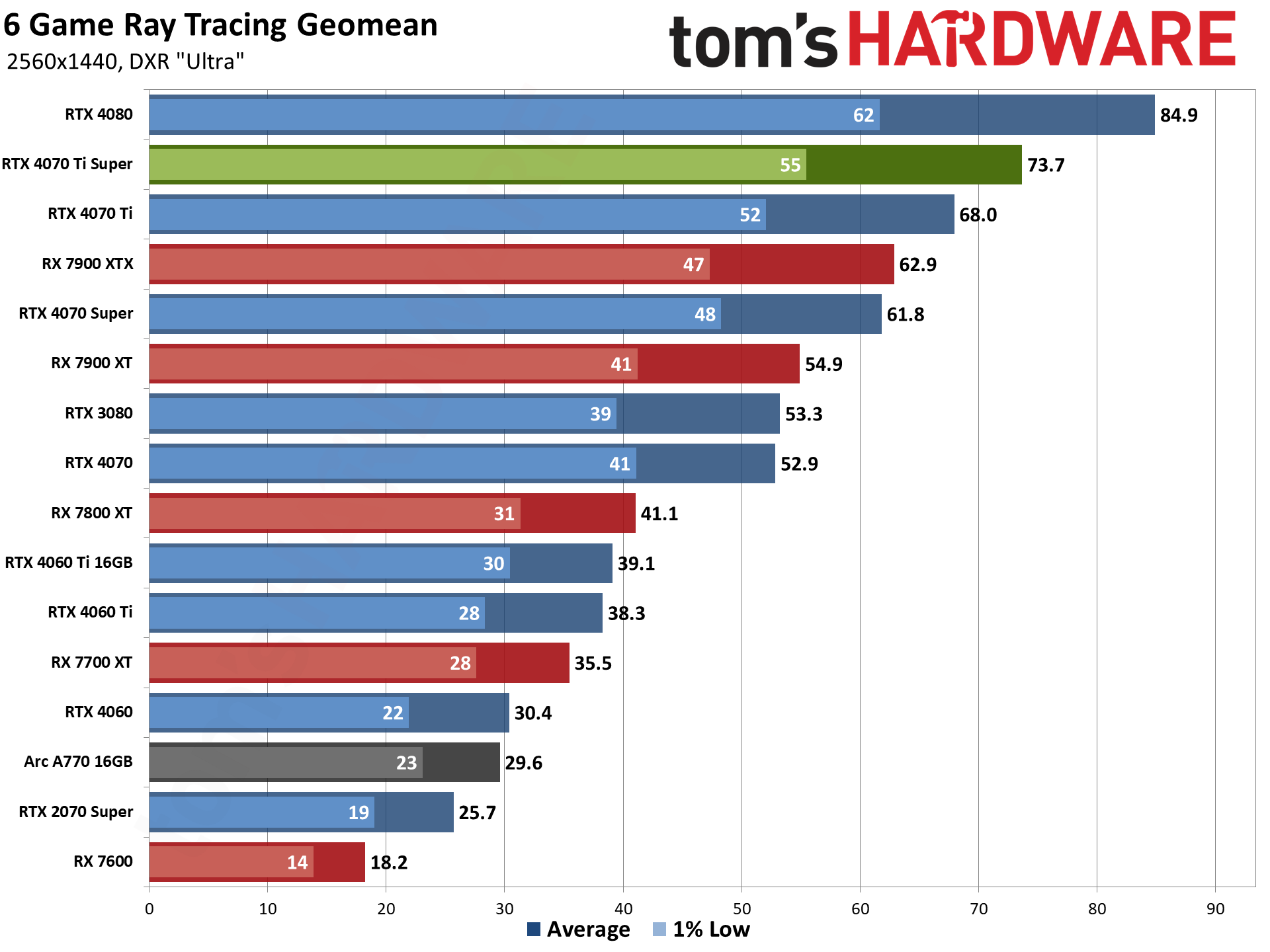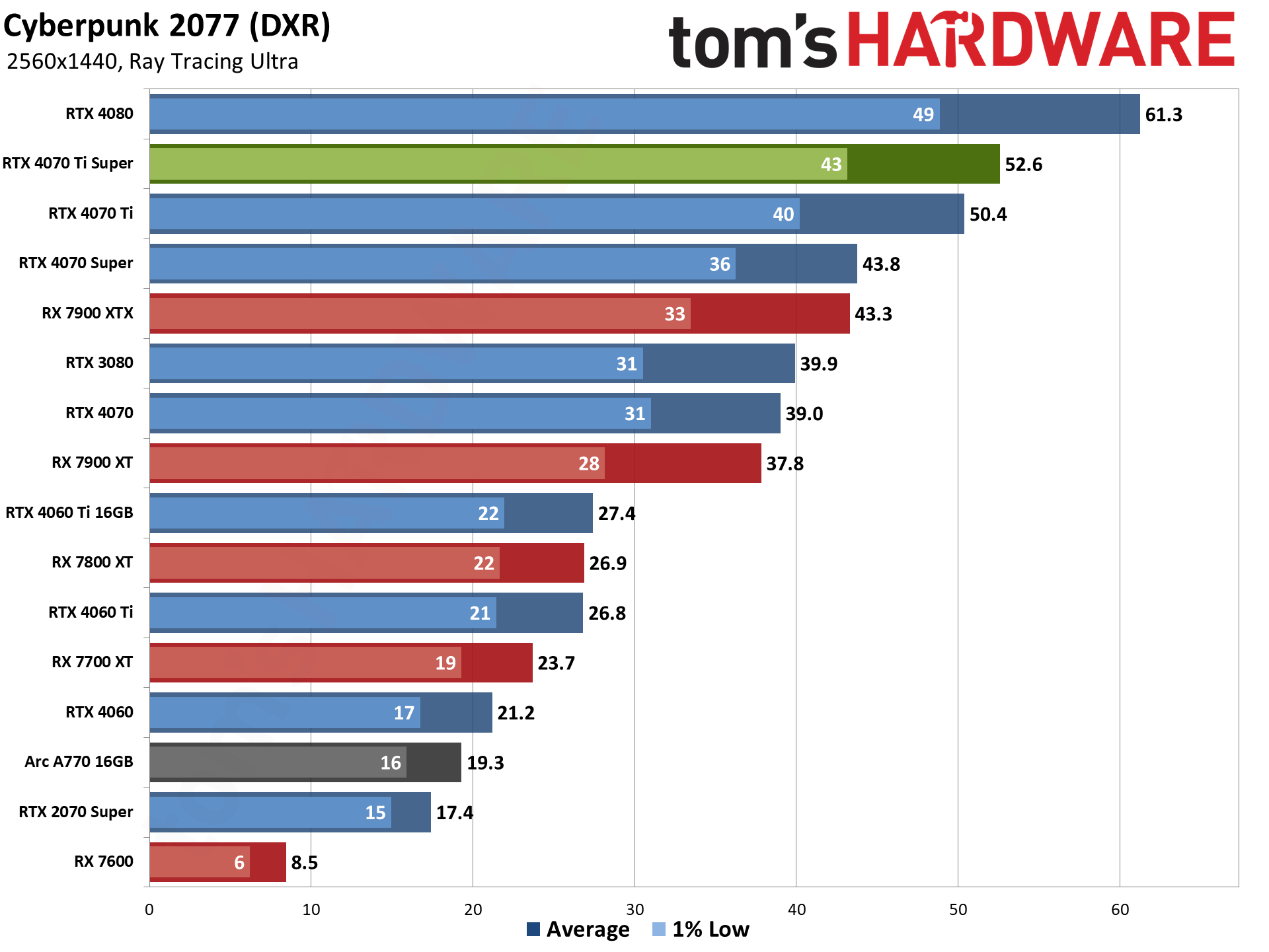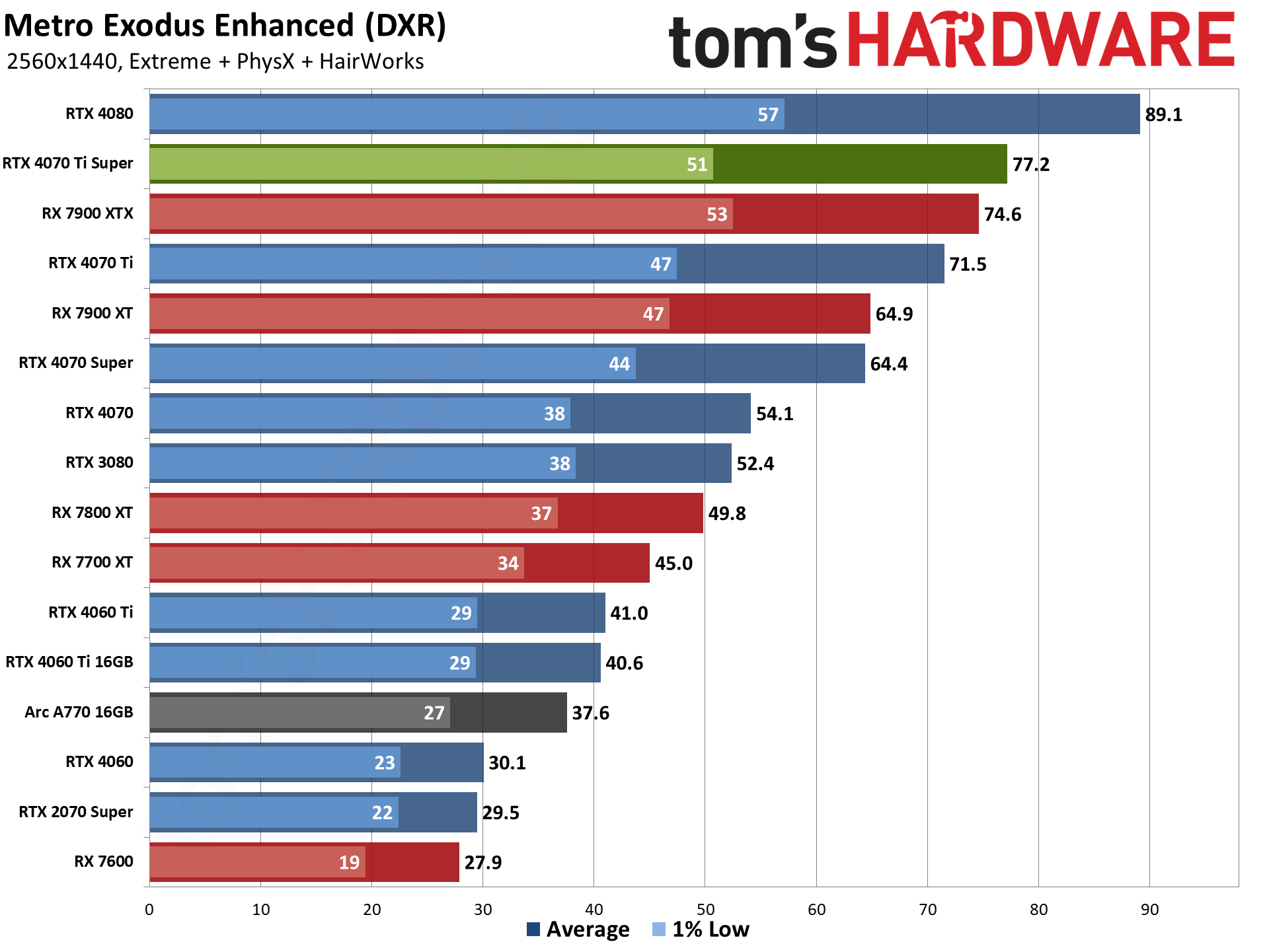Why you can trust Tom's Hardware
As mentioned on the previous page, the RTX 4070 Ti Super makes the most sense to us as a 1440p gaming solution — which is a close stand-in for 4K with DLSS Quality mode upscaling. So that's where we'll start our benchmarks.
We have 15 games and 18 charts, with the "high level overview" showing the geometric mean across all 15 games. Then we break things into rasterization and ray tracing test suites. Many will make the argument — and they're not wrong — that the performance hit from ray tracing doesn't match up with the improvement in rendering quality. Even in fully path traced games like Cyberpunk 2077 and Alan Wake 2, you basically need upscaling and often frame generation just to hit reasonable levels of performance. So, weigh things in your own mind as you see fit.
Like the 4070 Super review, we've added three "bonus" games further down the page, using Quality upscaling as our default in two of the games. Those results aren't included in our overall charts, as we haven't fully tested these games on all of the GPUs for this review, but they do help inform our view of how more demanding games in the future may run.
RTX 4070 Ti Super 1440p Overall Performance

When we first saw the specs, we felt the RTX 4070 Ti Super might come a lot closer to matching the RTX 4080 in performance. It turns out that it lands closer to the 4070 Ti than the RTX 4080 — it's 7% faster than the former, and 11% slower than the latter, at 1440p ultra.
That makes sense when you look at the raw compute and shader core counts, and provides a strong indication that our test suite doesn't particularly need a lot more bandwidth or VRAM capacity. Future games or higher resolutions can tip the scales slightly more in favor of the additional VRAM, however, and all things considered we're happier with 16GB than with 12GB on any card priced at $599 or higher.
What about older GPUs? The RTX 4070 Ti Super beats the RTX 3080 by 34% overall, and outperforms the RTX 2070 Super by a massive 150% — granted, it's priced higher than either of those were at launch, by $100 and $300, respectively. Anyone still using a GPU from two or more generations back now has plenty of reasons to consider an upgrade, in other words. And at the same time, probably in a year or so there will be even better reasons to upgrade when the inevitable RTX 50-series arrives.
Against AMD's GPUs, overall the RTX 4070 Ti Super now ties the fastest card from Team Red, the RX 7900 XTX. AMD still offers 50% more VRAM, and rasterization performance favors AMD by 12% as we'll see below, but as an overall package — and one that uses quite a bit less power — you can save about $150 by opting for Nvidia right now. Or alternatively, based on the least expensive $724 RX 7900 XT right now, you can get 14% better performance overall, including slightly faster rasterization performance, for $75 extra. That's 10% more money for 14% higher performance, and Nvidia's various ecosystem extras (i.e. DLSS). No wonder AMD announced promotional 7900-series price drops last week.
RTX 4070 Ti Super 1440p Rasterization Performance










The above high-level overview already tells us most of what we need to know, and our rasterization and ray tracing test suites consist of the usual tale of AMD rasterization versus Nvidia ray tracing differences. AMD's 7900 XTX wins in most of our rasterization suite, ranging anywhere from 3% slower (the CPU-limited Flight Simulator results) to as much as 33% faster (the AMD promoted Borderlands 3). But the 7900 XTX costs $150 more at present.
The RX 7900 XT ends up trading blows and losing in the overall rasterization metric by a couple percent. It's up to 16% slower (Total War: Warhammer 3) and 15% faster (Borderlands 3 again), basically splitting the nine games in terms of wins.
Of course no one is really going to care about the difference between 126 fps and 128 fps in overall performance, or even the biggest deltas of 145 fps vs. 167 fps (with AMD winning), or 125 fps vs. 105 fps (with Nvidia winning). Everything game remains easily playable at 1440p ultra if it's only using rasterization. Which brings us to ray tracing...
RTX 4070 Ti Super 1440p Ray Tracing Performance







AMD remains competitive in rasterization, and many continue to make the argument that ray tracing doesn't really matter that much. The problem with that thinking is that it's basically sticking your head in the sand and saying that new rendering techniques — the same ones that have been in use by Hollywood for decades — can't possibly matter. There still aren't many standout examples of ray tracing looking massively better than good rasterization approximations, but Nvidia's hardware proves that significantly higher levels of ray tracing are already within reach.
Looking at the similarly priced 7900 XT and 4070 Ti Super, Nvidia leads by 34% in our ray tracing suite, and the gaps can grow significantly with games that use higher levels of ray tracing — so-called path tracing. Minecraft is a 'lighter' example of this, where the Nvidia GPU is 85% faster overall, without factoring in upscaling.
And we do need to mention upscaling again, as DLSS remains more widely supported than FSR 2/3, and still looks better in our opinion. Plus FSR can run on Nvidia while DLSS can't run on AMD. If you're in the camp of gamers that really dislike Nvidia and refuse to support the company's proprietary technologies, nothing shown here will change your mind, but there are clearly reasons why Nvidia remains the dominant player in the GPU space.
RTX 4070 Ti Super 1440p Bonus Games



We've added three more recent games to our testing that tend to be more demanding than some of the older games in our suite. Alan Wake 2 is an Nvidia-promoted game that uses full path tracing (with "high" settings), while Avatar: Frontiers of Pandora and The Last of Us, Part 1 are AMD promoted games. We've enabled Quality mode upscaling in Alan Wake 2 and Avatar, with DLSS on Nvidia GPUs and FSR2/3 on AMD GPUs.
Alan Wake 2 with full path tracing represents the most demanding ray tracing game around right now, slightly surpassing Cyberpunk 2077 2.0 (with RT-Overdrive enabled). Testing at 1440p with high settings on both the standard preset and ray tracing, the 4070 Ti Super delivers 55 fps, which is certainly playable, particularly in a slower paced game like this. AMD's fastest GPU at 25 fps isn't playable, with less than half the performance of Nvidia's latest offering.
This is what we mean about new experiences being within reach. Nvidia continues to iterate on its ray tracing hardware, offering significant upgrades with every new architecture, and it shows. Even the previous generation RTX 3080 basically matches what you can get out of AMD right now, and while we won't say Alan Wake 2 absolutely requires ray tracing to be enjoyed, it does add to the experience on some level. Also, DLSS 3.5 ray reconstruction simply looks better than the standard denoising that's used on non-Nvidia hardware.
But not every new game will be like Alan Wake 2, and in fact so far the tally of fully ray traced games is a diminishing small number. That could change with the public availability of RTX Remix, however. Let's move on.
Avatar represents a more typical modern game, with some ray tracing enhancements (shadows and reflections), though we again note that the RT effects don't seem to alter the game's appearance much — they feel like more of a checkbox item, implemented in a way that doesn't tank performance as much, but also doesn't improve image fidelity either. Our updated testing has the RTX 4070 Ti beating the RX 7900 XTX by 5%, so Nvidia gets another win in this AMD-promoted game.
Our third and final bonus game is The Last of Us, Part 1, which has a reputation for needing lots of VRAM. As we've mentioned in other recent reviews, patches since the initial launch seem to have curbed its appetite for memory, but the game is very much tuned for AMD GPUs — similar to Borderlands 3 from our regular test suite. As such, the RTX 4070 Ti Super comes in a few percent behind the RX 7900 XT this time, while the 7900 XTX outperforms it by 18%.
- MORE: Best Graphics Cards
- MORE: GPU Benchmarks and Hierarchy
- MORE: All Graphics Content
Get Tom's Hardware's best news and in-depth reviews, straight to your inbox.
Current page: Nvidia RTX 4070 Ti Super: 1440p Gaming Performance
Prev Page Nvidia GeForce RTX 4070 Ti Super — Asus TUF Gaming Next Page Nvidia RTX 4070 Ti Super: 4K Gaming Performance
Jarred Walton is a senior editor at Tom's Hardware focusing on everything GPU. He has been working as a tech journalist since 2004, writing for AnandTech, Maximum PC, and PC Gamer. From the first S3 Virge '3D decelerators' to today's GPUs, Jarred keeps up with all the latest graphics trends and is the one to ask about game performance.
-
Loadedaxe As always, very thorough review. I wish these insane prices would come down to normal levels.Reply
If no one had credit cards, they would not be selling well at all. I am still going to hold out until the offerings from both AMDs and Nvidias next gen arrives. -
AgentBirdnest Wow, that's... disappointing, honestly. Like Jarred mentioned, I too was expecting it to be closer to the 4080. At the very least, I thought it would consistently outperform the 7900XT at 1440p.Reply
I had my eye on this card to finally replace my RTX 2060, but after seeing these benchmarks, I'm not so sure.
Part of me wants to have the better memory specs, in case games coming over the next few years will benefit more from it (Alan Wake seems to show that.) And I may upgrade from 1440p to 4K, but not for at least a year. But futureproofing is hard, since I don't own a crystal ball.
The other part of me thinks the 4070 Super is close enough in performance, and I could use the saved $200 to buy a 4TB SSD that I could make use of. But I don't wanna regret my decision in 2 years.But with either choice, I'm sure I'll be absolutely ecstatic when I upgrade from my 2060. : P
In any case - awesome review, Jarred! You do great work. : ) -
Colif Nvidia repeating what they did with 2070 Super.Reply
4070 TI Super is mostly a 4080
2070 Super was mostly a 2080
Guess old play book worked back then.
8U_S8vrRs-Y -
DavidLejdar Thanks for the detailed review! I don't care much for ray-tracing. So, if I'd upgrade towards 4K, it looks like the RX 7900 XT would be a better option for me - as it is a bit cheaper and with a bit more rasterization performance.Reply
It sure ain't cheap. In my case, I easily miss out on some other stuff though. I.e., it hasn't been until 2023 that I got me a smartphone (and then only a cheap one) - meanwhile at home, a rig with DDR5 RAM already, which should last some years.Loadedaxe said:As always, very thorough review. I wish these insane prices would come down to normal levels.
If no one had credit cards, they would not be selling well at all. I am still going to hold out until the offerings from both AMDs and Nvidias next gen arrives.
Also, here in Germany, we have universal health-care and federal minimum wage of 12.42 Euro. So even with locally low salary (full-time), and after payslip-deductions (such as for that mandatory health-care insurance), and with not too high a rent (as not every owner here needs money for a golf course), it is possible to save up a bit for a rig (without worry of needing a fortune for medical expenses).
And some accountancy helps too. Like, when someone spends i.e. $2 a day on fizzy drinks, drinking water instead means a saving of nearly $60 a month, or $720 a year. Smoking? Smoke some less. And voila, $800 for a GPU, while having improved health.
Not saying that I will get me a new GPU soon, and no reason to overspend of course. And if I'd be living in the countryside, to begin with, I'd would likely need a car and pay insurance for it, even if driving only a few miles every day on empty roads. Etc. But if one can put aside some $40 a month (without interest rate), not that tough to have a modern rig. -
cknobman AMD will likely need to lower the MSRP of the 7900 cards.Reply
Smart move would be to match the 7900XTX msrp to the new 4070ti Super. -
Devoteicon Reply
They are normal.Loadedaxe said:I wish these insane prices would come down to normal levels. -
Eximo All I can say is, go Intel? Need a disruption in the upper mid-range for sure. Even if it is 4070 Super / 7800XT levels of performance that would kick off some re-pricing.Reply -
FoxtrotMichael-1 Reply
I'm not sure what else you spend your money on but inflation has affected every aspect of the economy. Just about everything I buy for a family of 5 is twice as expensive as it was a decade ago.Loadedaxe said:I wish these insane prices would come down to normal levels. -
Gururu Reply
100% agree and watching for itEximo said:All I can say is, go Intel? Need a disruption in the upper mid-range for sure. Even if it is 4070 Super / 7800XT levels of performance that would kick off some re-pricing. -
edzieba ReplyThere's surprisingly little uplift in most games from the memory upgrades
No surprise at all: the 4xxx (and 3xxxs) series have not been memory capacity limited in any of the cards released thus far. Even the 4060Ti 8/16gb only started to see serious performance disparities when settings were cranked far enough for the performance choice to be between "not very good" and "still not very good", so 12GB/16GB is going to offer naff-all in real world testing.
Remember: buy cards based on actual benchmarking (ideally of the games you play), not based on numbers on the box.
